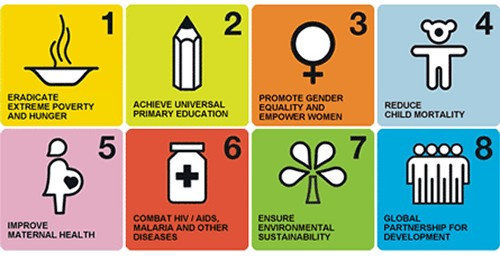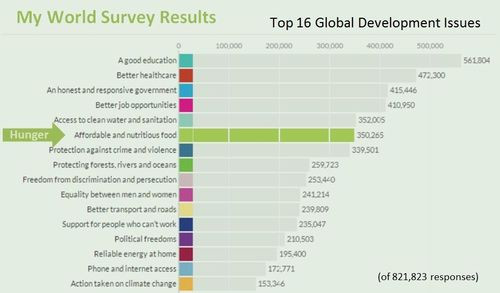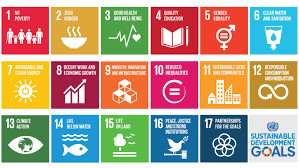The IoT4SDG Challenge
At the end of 2014 the United Nations released the results of the largest survey ever undertaken in its 70-year history, reaching over seven million people in 88 countries all over the world. The My World survey was one input to three years of negotiations and debate climaxing in September 2015 when 193 countries agreed to a set of 17 development goals and 169 targets to be achieved by 2030. In 2016 the international community is embarking on the implementation of these goals and targets. What’s this all about?
The well-known Millennium Development Goals (MDGs) set by the United Nations back in 2000 consisted of eight anti-poverty targets that the world committed to achieving by 2015. The MDGs were aimed at an array of issues that included actions on poverty, hunger, disease, illiteracy, gender inequality, and access to water and sanitation (Figure 1).
Figure 1: The Millennium Development Goals
Were the MDGs achieved?
The UN's Millennium Development Goals Report asserts that “The global mobilization behind the Millennium Development Goals has produced the most successful anti-poverty movement in history” noting that the MDGs “helped to lift more than one billion people out of extreme poverty, to make inroads against hunger, to enable more girls to attend school than ever before and to protect our planet.”
But the MDGs have been criticised for being too narrow in focus. Although significant progress was made over the 15 year period the benefits were often confined to specific regions and social groups. A 2015 UN assessment of the MDGs noted: “The assessment of progress towards the MDGs has repeatedly shown that the poorest and those disadvantaged because of gender, age, disability or ethnicity are often bypassed.”
2030 Agenda for Sustainable Development
The UN has responded to such criticisms in its 2030 Agenda for Sustainable Development, which includes a set of 17 Sustainable Development Goals (SDGs) to end poverty, fight inequality and injustice, and tackle climate change by 2030. These SDGs, adopted by world leaders in September 2015, build on the MDGs by addressing a wider range of issues, from gender inequality to climate change, with the unifying thread of a commitment to ending poverty.
The SDGs benefitted from an inclusive consultation process. The My World survey gathered data from seven million people focusing on youth and developing countries, asking them to select six out of 16 priorities for a better life. The priorities returned by the survey are shown in Figure 2.
Figure 2: Extract from the My World survey results
This exercise recognised that the MDGs failed certain people and countries. The 2030 Agenda for Sustainable Development deliberately sets out to “reach the furthest behind first” and concludes with a pledge that “no one will be left behind”.
Sustainable Development Goals
The new SDGs, and the broader sustainability agenda, go much further than the MDGs, addressing the root causes of poverty and the universal need for development that works for all people. The 193 countries that agreed to the 17 SDGs in September 2015 have signed up to a set of development goals more bold and ambitious than anything that has come before them (Figure 3).
Figure 3: Sustainable Development Goals
1. No Poverty – End poverty in all its forms everywhere.
2. Zero Hunger – End hunger, achieve food security and improved nutrition and promote sustainable agriculture.
3. Good Health and Well-being – Ensure healthy lives and promote well-being for all at all ages.
4. Quality Education – Ensure inclusive and equitable quality education and promote lifelong learning opportunities for all.
5. Gender Equality – Achieve gender equality and empower all women and girls.
6. Clean Water and Sanitation – Ensure availability and sustainable management of water and sanitation for all.
7. Affordable and Clean Energy – Ensure access to affordable, reliable, sustainable and clean energy for all.
8. Decent Work and Economic Growth – Promote sustained, inclusive and sustainable economic growth, full and productive employment and decent work for all.
9. Industry, Innovation and Infrastructure – Build resilient infrastructure, promote inclusive and sustainable industrialization and foster innovation.
10. Reduced Inequalities – Reduce inequality within and among countries.
11. Sustainable Cities and Communities – Make cities and human settlements inclusive, safe, resilient and sustainable.
12. Responsible Consumption and Production – Ensure sustainable consumption and production patterns.
13. Climate Action – Take urgent action to combat climate change and its impacts.
14. Life Below Water – Conserve and sustainably use the oceans, seas and marine resources for sustainable development.
15. Life on Land – Protect, restore and promote sustainable use of terrestrial ecosystems, sustainably manage forests, combat desertification, and halt and reverse land degradation and halt biodiversity loss.
16. Peace, Justice and Strong Institutions – Promote peaceful and inclusive societies for sustainable development, provide access to justice for all and build effective, accountable and inclusive institutions at all levels.
17. Partnerships for the Goals – Strengthen the means of implementation and revitalize the global partnership for sustainable development.
The SDGs and their associated targets are clearly unobtainable without major transformations of business models, the global economy and societies. The hope is that Information and Communication Technologies (ICTs) will provide the necessary innovation to drive such transformations.
ICT and SDGs
Access to clean water is number 5 in the My World survey priority list (Figure 2). Access to phones and the internet is number 15. Few would argue with those priorities. Yet they shouldn’t necessarily be taken literally. Speaking on a panel at ITU Telecom 2012, Jennifer May of McKinsey made an important observation.
“Imagine you are a parent in rural sub-Saharan Africa. Your child is sick. You know it's from drinking water, contaminated water. They've got diarrhoea, and almost a million kids around the world die from this a year. What do you do? Do you keep giving them bad water, or do you stop?” asked May. She continued “They did a survey in parts of rural India where up to 50% of mothers said bad water, stop. Makes sense; right? Unfortunately, this leads directly to a lot of these infants dying. Had they been able to pick up the phone and call a phone doctor, that with a bit of advice on salt, sugar, and what to do with their child, would have saved fundamental lives.”
Lack of access to clean water is a major cause of diarrhoea in infants. The natural reaction of a parent without access to clean water is to stop giving liquids to a child with severe diarrhoea. This can be fatal. Between 2000 and 2003 there were 10.6 million yearly deaths in children younger than 5 years old; 1.9 million (18%) of those were caused by diarrhoea.
There is a simple remedy: an Oral Rehydration Salts solution using boiled water, sugar and salt. This life-saving remedy could be prescribed over the phone.
New data from the ITU show that in 2016, over two-thirds of the world’s population lives within an area covered by a mobile broadband network and that ICT services continue to become more affordable.
Jennifer May again: “In most of these places, there are phones. There are mobile phones. And there isn't running water. So build on what you've got.”
The IoT4SDG challenge
The Internet of Things will undoubtedly play a major role in achieving many of the SDGs. But, given the SDGs’ emphasis on the developing world, is the IoT community focusing on applications and services that will prioritise the needs of the neediest and so support the SDGs? Is the community addressing the barriers that need to be overcome to ensure the implementation of the innovative solutions that will be necessary to transform the global economy and societies?
The recipients of this newsletter – the more than 13,000 members of the IEEE IoT Technical Community – are well placed to answer these questions. We welcome your thoughts on how IoT can support specific SDGs and what regulatory and social changes will be necessary to reach these goals.
 Stuart Sharrock has been working as an analyst and consultant in the telecommunications industry for the past three decades. He holds a BSc in Natural Philosophy from Edinburgh University and a PhD in Nuclear Physics from University College London and has conducted research in nuclear physics in the Soviet Union, Switzerland, the UK and the USA. He lectured in physics at UCL before entering the commercial world as the Physical Sciences Editor of Nature, the world's leading peer reviewed scientific journal, and subsequently as a publisher of scientific books and journals for a number of major publishing houses before becoming an independent analyst and consultant. Stuart is a member of the IEEE and the Managing Editor of the IEEE IoT eNewsletter.
Stuart Sharrock has been working as an analyst and consultant in the telecommunications industry for the past three decades. He holds a BSc in Natural Philosophy from Edinburgh University and a PhD in Nuclear Physics from University College London and has conducted research in nuclear physics in the Soviet Union, Switzerland, the UK and the USA. He lectured in physics at UCL before entering the commercial world as the Physical Sciences Editor of Nature, the world's leading peer reviewed scientific journal, and subsequently as a publisher of scientific books and journals for a number of major publishing houses before becoming an independent analyst and consultant. Stuart is a member of the IEEE and the Managing Editor of the IEEE IoT eNewsletter.
Sign Up for IoT Technical Community Updates
Calendar of Events
IEEE 8th World Forum on Internet of Things (WF-IoT) 2022
26 October-11 November 2022
Call for Papers
IEEE Internet of Things Journal
Special issue on Towards Intelligence for Space-Air-Ground Integrated Internet of Things
Submission Deadline: 1 November 2022
Special issue on Smart Blockchain for IoT Trust, Security and Privacy
Submission Deadline: 15 November 2022
Past Issues
September 2022
July 2022
March 2022
January 2022
November 2021
September 2021
July 2021
May 2021
March 2021
January 2021
November 2020
July 2020
May 2020
March 2020
January 2020
November 2019
September 2019
July 2019
May 2019
March 2019
January 2019
November 2018
September 2018
July 2018
May 2018
March 2018
January 2018
November 2017
September 2017
July 2017
May 2017
March 2017
January 2017
November 2016
September 2016
July 2016
May 2016
March 2016
January 2016
November 2015
September 2015
July 2015
May 2015
March 2015
January 2015
November 2014
September 2014





